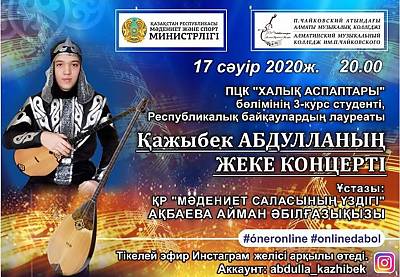The coronavirus pandemic (COVID-19) has severely affected Kazakhstan, located at the intersection of many transport corridors between East and West, North and South. Protective measures began to be applied almost immediately, but from March 16, 2020, President Kassym-Jomart Tokayev was forced to introduce a state of emergency in the country.
The strict self-isolation regime was a serious blow to the living heritage of the Kazakh people: after all, the celebration of Nauryz, included in the ICH Representative List, begins in Kazakhstan on March 14 with the Körisu tradition, which consists in visiting parents and friends in order to find out about their health and well-being after the winter.
Deserted and silent squares and streets of cities and villages of Kazakhstan instead of the noisiest and most joyful ancient holiday - this will go down in the history of Nauryz 2020. However, the communities - large and small ones - have worthily accepted this challenge, using the facilities of IT technologies.
Almost from the first days of the quarantine regime, the Internet space was filled with performances of bearers of living heritage, representing various genres, but especially singers and kuyshis. Kuyshi is the performer of the Kazakh traditional art of Dombra Kuy, an element included in the Representative List of the Intangible Cultural Heritage of Humanity.
In the framework of the nationwide action “Biz birgemiz”-“We are together”, many well-known performers of this genre as well as very young dombra players record performances at home and post them on social networks: FB, Instagram, etc.
Online concerts, both solo and ensemble, have become a new form that has gained popularity precisely in a pandemic. Their organizers are free communities, but also institutional structures. So, for example, Almaty Music College named after P.I. Tchaikovsky and the Ministry of Culture and Sports supported a home online concert of a College’s 3rd year student Abdullah Kazhybek, winner of a number of national traditional music competitions.
For the first time in the history of this college, one student gave a recital, and for the first time - online, and for the first time – from home. The 45-minute program consisted of 12 dombra kuys, most of which are not well known to a wide audience. Therefore, the young kuyshi forwarded each work with short stories about their history and authors. The concert was held on the Instagram platform by the «live translation»; it was actively watched by a community of about 470 people in all regions of Kazakhstan. Thereafter the concert was hosted by one of the admirers of Abdullah Kazhybek’s talent in YouTube, where he was watched by more than two hundred members of the community of connoisseurs of dombra kuy.
Besides such concerts, other new forms of appeal to the living heritage appeared during strict quarantine. For example, on April 23 a truly global online ceremony of the Tengrian rite of birth of the new moon took place at the initiative of the Kazakhstan youth movement Neonomad via Zoom video-conference platform and lasted several hours.
The bearers and practitioners of traditional knowledge and practices concerning nature and the universe from the regions of Kazakhstan, Turkey, Germany, the USA (Oklahoma, New York), Peru, Russia (Buryatia and some others republics of the RF) have consistently joined it. In total, over one hundred people took part in this amazing ritual.
By and large we can say that in Kazakhstan, in the context of the fight against COVID-19, people began to turn more to the living heritage, finding in it not only an emotional outlet in a situation of self-isolation, but also as a spiritual support for an optimistic view of the future.
Solo concert of Kazhybek Abdulla
Las designaciones utilizadas y la presentación de los textos y documentos presentados en esta plataforma no suponen ninguna toma de posición por parte de la UNESCO acerca de la condición jurídica de los países, territorios, ciudades o zonas ni respecto al trazado de sus fronteras o límites.
